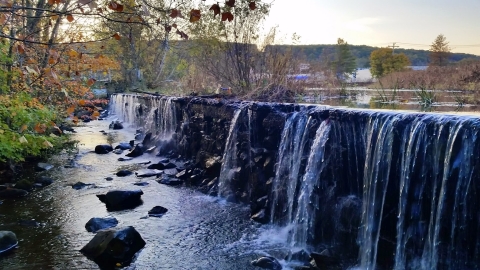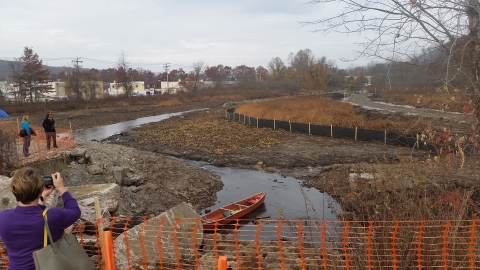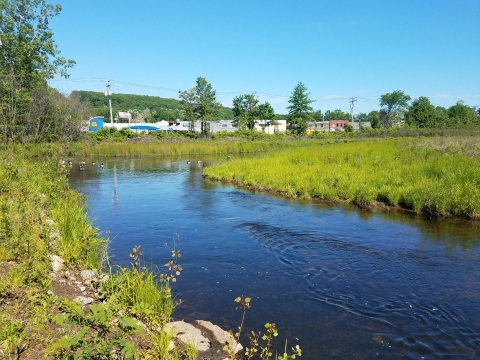Frank DeLeo remembers seeing dead alewives float up West River when he was young. Now, half a century later, he’s become a devout steward of the fish’s restored waterway.
“They [the Pond Lily Company] used to release the textile waste into the river, right where the Pond Lily Dam was years ago,” he said.
“They had these big tanks that looked like swimming pools. The [pools] would be all filled up with these blue or red or whatever dye and then they would just open the thing at low tide, since they figured it would just get washed out with the tide.”
I walked with DeLeo along the river, which runs next to a strip mall and highway in New Haven, Connecticut. The site, now Pond Lily Preserve, is unrecognizable from its past.
The dam and resulting impoundment are gone, and the river is now free-flowing—and long cleaned up from its days as a hazardous waste site. Thanks in part to the U.S. Fish and Wildlife Service, it no longer floods the neighborhood each time it rains, and the surrounding preserve and trail system is lush with marsh plants. It’s a place that now fosters alewife runs up the river to their spawning grounds every spring, and it’s a place that now facilitates outdoor recreation for locals who have long been denied such a thing, in their dense, urban environment.
Restoring the River
“It really warms my heart to walk these trails,” DeLeo said.
He has seen the scope of Pond Lily’s transformation, from the days of a murky, polluted river, through a muddy post-removal construction site, to today’s flourishing preserve.
“I am a fly fisherman, and I really like to see clean, clear water. The West River is a great resource, and I think it should be protected. The way it’s going to be protected is by the local people who take an interest in it,” he said.
The Pond Lily Preserve looks this way today because of the interest local people took in protecting the river and restoring ecosystems with an eye towards the climate of the future—rather than returning failing infrastructure to the man-made conditions of the past.
DeLeo was part of the West River Flood Mitigation Committee, which long sounded the alarm on the dam’s continued flooding of their neighborhood. The New Haven Land Trust, which owned the nearly 210-year-old dam, took notice. The trust learned that on top of the frequent rainy-day flooding, the aging dam threatened “catastrophic failure” and a deluge of the New Haven neighborhood. The Trust, which has since become Gather, was left with a choice: repair the decrepit dam or remove it altogether. While the former was far cheaper, the latter would offer a wealth of benefits to wildlife, the ecosystem, and the surrounding community.
“We wanted to solve it in a way that solved it permanently,” said JR Logan, former board member of New Haven Land Trust.
Such a decision aligned with the Fish and Wildlife Service’s efforts to increase coastal resilience, which contributed more than $660,000 in Hurricane Sandy relief funding to remove the Pond Lily dam and restore its surroundings. The New Haven Land Trust partnered with Save the Sound, whose engineers and scientists designed the intricate process of safely removing the dam and returning the former impoundment to wetland habitat.
Ten years since the super-storm, the project has become one of the crown jewels of the Service’s Hurricane Sandy Program. The Pond Lily restoration embodies the values of resilience: It lets natural systems lead the way so that ecosystems can function as they’re meant to; it restores a landscape for the future conditions of climate change climate change
Climate change includes both global warming driven by human-induced emissions of greenhouse gases and the resulting large-scale shifts in weather patterns. Though there have been previous periods of climatic change, since the mid-20th century humans have had an unprecedented impact on Earth's climate system and caused change on a global scale.
Learn more about climate change , rather than those of the past; and it does so in a way that directly benefits the surrounding community, by providing both access to the outdoors and protection from storm surge and flooding.
“It’s kind of the world’s most perfect restoration site,” said Jon Vander Werff, Save the Sound’s fisheries biologist.
Completing the nutrient cycle
Vander Werff has a front row seat to the restoration’s success. As a fisheries monitor, he tracks the slew of wildlife that work their way up West River each spring.
That monitoring has yielded essential ecological data that can position Pond Lily as a model, especially as the federal Bipartisan Infrastructure Law Bipartisan Infrastructure Law
The Bipartisan Infrastructure Law (BIL) is a once-in-a-generation investment in the nation’s infrastructure and economic competitiveness. We were directly appropriated $455 million over five years in BIL funds for programs related to the President’s America the Beautiful initiative.
Learn more about Bipartisan Infrastructure Law offers funding for similar dam removal and infrastructure projects that facilitate fish passage fish passage
Fish passage is the ability of fish or other aquatic species to move freely throughout their life to find food, reproduce, and complete their natural migration cycles. Millions of barriers to fish passage across the country are fragmenting habitat and leading to species declines. The U.S. Fish and Wildlife Service's National Fish Passage Program is working to reconnect watersheds to benefit both wildlife and people.
Learn more about fish passage .
“We see everything,” Vander Werff said, excitedly listing the eccentric aquafauna that made their way through his monitoring fish trap: gizzard shad, eel, sea lamprey, and even a chrome-colored brook trout — which he took as a sign of the system’s relative health, since brook trout are particular about the quality of their habitat.
But no species in the West River has been as important as the alewife, a river herring that returns from the ocean each year to swim upstream and breed in freshwater ponds and lakes. Two centuries of damming prevented nearly any alewife from making that trip up West River, and the ecosystem suffered without the species and the essential upstream movement of nutrients they offer.
But, as soon as the dam came out, the fish came back.
“Alewife are the coolest, most resilient fish there are,” Vander Werff said.
“They [complete the nutrient cycle from ocean to river] by doing all their feeding out in the open ocean. Then on their in-migration, everything loves to eat them — from birds of prey, great blue heron to raccoons, snapping turtle, other fish, seals, lobster, sportfish like bass, bluefish, tuna, even whale are documented eating them.” Vander Werff had to pause to catch his breath. “Excuse me I am getting myself excited. As I should!”
It’s rare, Vander Werff explained, for nutrients to move back up the river.
Without alewife, the system was missing the crucial transfer of nutrients and suffering for it. Restoring this natural cycle has been one of the greatest boons of the Pond Lily Dam removal. The entire food web and ecosystem that hinged upon consumption of alewife by birds and fish has been righted.
Yet, for the first time since the restoration, this year, Pond Lily saw few alewives. Vander Werff thinks it’s due to changes in policy for fishing zones in Long Island Sound. DeLeo blames the region’s drought, which caused lower water levels and revealed obstacles earlier in the stream. All agree, however, that it’s too early to know.
This drop is a reminder of the larger challenges the preserve is up against. Though this stretch of river and the land surrounding it have been newly bolstered against intense storms and altered rain patterns, it is not immune to the ever-growing threats of a changing climate. Nor is the rest of West River, Connecticut, Long Island Sound, or New England; the rest of the larger ecosystem Pond Lily sits in, and relies on, remains vulnerable to climate change.
Connecting with Community
New Haven’s mayor, Justin Elicker, who was executive director of New Haven Land Trust before he was elected, pointed out the dam’s connections with the larger ecosystem as we visited the site with Logan, the former board member.
He noted a rehab facility and city housing on our way into Pond Lily: “The cool thing about this preserve is that it’s behind this city housing development.” He gestured to the homes that literally back up to the land. “The people who live here can use this as a backyard.”
“There are neighborhoods right here,” said Logan when we were in the preserve. “Typically, there’s not as much access to natural areas, so it’s important there’s some investment in it. It’s important that this exists.”
DeLeo now dedicates his efforts to the West River Watershed Coalition, a group focused on cleaning up and connecting trails along the river. Occasionally, when he’s out maintaining trails, he sees residents of the rehab facility playing basketball at the nearby court, and they’ll offer a hand in cleaning up the trails. “There are some really nice people. They’re happy we’re trying to keep the place nice.”
Gather (née New Haven Land Trust) is now seeking ways to use the space in ways that benefit its neighbors.
“How can we best support neighbors having green space? What programs that could occur through here do people really need?” Gather’s environmental education and engagement director, Karen Nelson asked.
She dreams of a day when shoppers at the nearby strip mall can “get a cold beverage, sit and enjoy nature” in the midst of their errands.
DeLeo envisions a bridge crossing the river to connect the housing development more directly with the shopping center.
Now, as mayor, Elicker can see how this little patch of green space fits into the broader, human ecosystem of the city.
In addition to the connection with nature access to the outdoors can facilitate, Elicker noted the great public health benefits such a space can provide, both physical and mental.
The energy and engagement behind the removal is itself what drew many in the community to Pond Lily in the first place.
“By taking the dam down, a lot of interests got activated,” DeLeo said. “We got all kinds of help after that to become stewards of the river.”
After a long road of restoration work that led to today’s preserve, simple stewardship work is what lies ahead for Pond Lily.
“What’s next is just keeping the river, becoming stewards of the river. Now that it’s become better, we’re just continuing to improve it,” said DeLeo.







